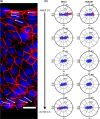Multiaxial Polarity Determines Individual Cellular and Nuclear Chirality
- PMID: 28360944
- PMCID: PMC5367857
- DOI: 10.1007/s12195-016-0467-2
Multiaxial Polarity Determines Individual Cellular and Nuclear Chirality
Abstract
Intrinsic cell chirality has been implicated in the left-right (LR) asymmetry of embryonic development. Impaired cell chirality could lead to severe birth defects in laterality. Previously, we detected cell chirality with an in vitro micropatterning system. Here, we demonstrate for the first time that chirality can be quantified as the coordination of multiaxial polarization of individual cells and nuclei. Using an object labeling, connected component based method, we characterized cell chirality based on cell and nuclear shape polarization and nuclear positioning of each cell in multicellular patterns of epithelial cells. We found that the cells adopted a LR bias the boundaries by positioning the sharp end towards the leading edge and leaving the nucleus at the rear. This behavior is consistent with the directional migration observed previously on the boundary of micropatterns. Although the nucleus is chirally aligned, it is not strongly biased towards or away from the boundary. As the result of the rear positioning of nuclei, the nuclear positioning has an opposite chirality to that of cell alignment. Overall, our results have revealed deep insights of chiral morphogenesis as the coordination of multiaxial polarization at the cellular and subcellular levels.
Keywords: Cell Chirality; Cell Morphology; Cell Polarity; Nuclear Morphology.
Conflict of interest statement
CONFLICT OF INTEREST All authors, Michael J. Raymond, Poulomi Ray, Gurleen Kaur, Michael Fredericks, Ajay V. Singh, and Leo Q. Wan, declare that they have no conflict of interest.
Figures




Similar articles
-
Cellular and Nuclear Alignment Analysis for Determining Epithelial Cell Chirality.Ann Biomed Eng. 2016 May;44(5):1475-86. doi: 10.1007/s10439-015-1431-3. Epub 2015 Aug 21. Ann Biomed Eng. 2016. PMID: 26294010 Free PMC article.
-
Asymmetrical positioning of cell organelles reflects the cell chirality of mouse myoblast cells.APL Bioeng. 2024 Mar 14;8(1):016119. doi: 10.1063/5.0189401. eCollection 2024 Mar. APL Bioeng. 2024. PMID: 38495528 Free PMC article.
-
Cell chirality: emergence of asymmetry from cell culture.Philos Trans R Soc Lond B Biol Sci. 2016 Dec 19;371(1710):20150413. doi: 10.1098/rstb.2015.0413. Philos Trans R Soc Lond B Biol Sci. 2016. PMID: 27821525 Free PMC article. Review.
-
Left-right asymmetry is formed in individual cells by intrinsic cell chirality.Mech Dev. 2014 Aug;133:146-62. doi: 10.1016/j.mod.2014.04.002. Epub 2014 May 4. Mech Dev. 2014. PMID: 24800645
-
Cell Chirality as a Novel Measure for Cytotoxicity.Adv Biol (Weinh). 2022 Jan;6(1):e2101088. doi: 10.1002/adbi.202101088. Epub 2021 Nov 19. Adv Biol (Weinh). 2022. PMID: 34796704 Free PMC article. Review.
Cited by
-
Cell chirality in cardiovascular development and disease.APL Bioeng. 2020 Aug 25;4(3):031503. doi: 10.1063/5.0014424. eCollection 2020 Sep. APL Bioeng. 2020. PMID: 32903894 Free PMC article. Review.
-
Cell chirality exhibition of brain microvascular endothelial cells is dependent on micropattern width.RSC Adv. 2022 Oct 21;12(46):30135-30144. doi: 10.1039/d2ra05434e. eCollection 2022 Oct 17. RSC Adv. 2022. PMID: 36329947 Free PMC article.
-
Cell organelle-based analysis of cell chirality.Commun Integr Biol. 2019 Apr 24;12(1):78-81. doi: 10.1080/19420889.2019.1605277. eCollection 2019. Commun Integr Biol. 2019. PMID: 31143366 Free PMC article.
-
Astrocytic RNA editing regulates the host immune response to alpha-synuclein.Sci Adv. 2025 Apr 11;11(15):eadp8504. doi: 10.1126/sciadv.adp8504. Epub 2025 Apr 11. Sci Adv. 2025. PMID: 40215316 Free PMC article.
-
Epithelial Cell Chirality Revealed by Three-Dimensional Spontaneous Rotation.Proc Natl Acad Sci U S A. 2018 Nov 27;115(48):12188-12193. doi: 10.1073/pnas.1805932115. Epub 2018 Nov 14. Proc Natl Acad Sci U S A. 2018. PMID: 30429314 Free PMC article.
References
Grants and funding
LinkOut - more resources
Full Text Sources
Other Literature Sources
Research Materials

